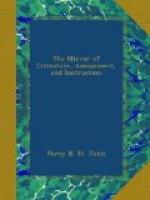The fraternity continued to flourish in the next reigns; and in the reign of Elizabeth, about 1550, Sir Thos. Sackville, then grand master, assembled the general lodge at York, which is said to have roused the jealousy of the queen; and she intended to break up the meeting, but being informed that they did not meddle with politics, she withdrew her orders, and permitted them to meet unmolested. Sackville was succeeded by Sir Thomas Gresham, in the south, who built the Royal Exchange, and by Francis Russell, Earl of Bedford, in the north.
Masonry continued to flourish in the next reign, under Inigo Jones, as grand master, till 1618, when the Earl of Pembroke succeeded him; and after some more changes, Jones again was elected, and continued to preside till his death, in 1646. But the civil war again obstructed the progress of the order, until the Restoration, when it revived under the auspices of Charles II.
In 1663, the Earl of St. Alban’s was elected grand master, who appointed Mr. (afterwards Sir Christopher) Wren his deputy; which office he held until 1685, when he was himself appointed to the grand chair. During his deputy-ship he erected many noble buildings, particularly the cathedral of St. Paul’s.
The short reign of James II. was not favourable to the order of masons; nor did it begin again to revive for many years. King William III. was initiated privately in 1695, and approved the choice of Sir Christopher Wren as grand master; but shortly after, and during the whole reign of Queen Anne, the society decreased gradually, for the grand master’s age prevented his attending regularly, and the annual feasts were neglected.
On the accession, therefore, of Geo. I. the masons in London determined to revive, if possible, the grand lodge and the communications of the society under a new grand master, Sir Christopher Wren being dead. In February, 1717, accordingly, the only four lodges then existing in London met, and voting the oldest master mason, constituted themselves a grand lodge; and on St. John Baptist’s day, meeting again, they elected Anthony Sayer, Esq., grand master, and he was regularly installed by the grand master who had before been voted into the chair.
Mr. Sayer was succeeded by George Payne, Esq., in 1718, who collected all the records of the society—by which means some copies of the old Gothic constitutions were produced and arranged. In 1719, Dr. Desaguliers was grand master, and by his activity the order made great progress; and at the feast of his installation, the custom of drinking healths was first introduced. In the next, year, under Mr. Payne again, the fraternity sustained a great loss by the burning of some valuable manuscripts, by some too scrupulous brethren; and next year, the Duke of Montague was proposed for, and accepted the chair of grand master.
* * * * *




